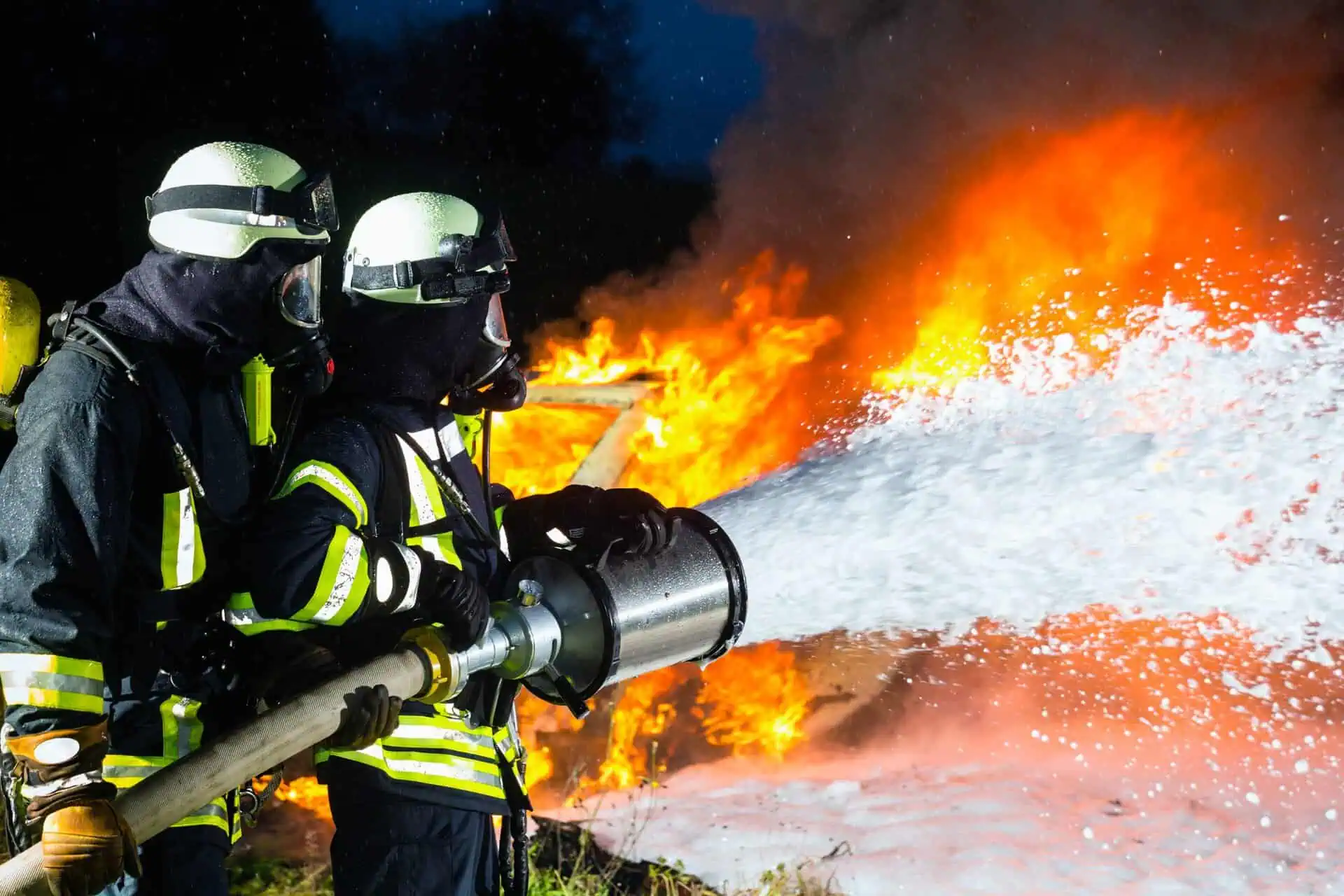AFFF Bladder Cancer Lawsuit: Uncovering Cancer Link
- Last Updated: June 12th, 2025

Attorney Jessica Paluch-Hoerman, founder of TruLaw, has over 28 years of experience as a personal injury and mass tort attorney, and previously worked as an international tax attorney at Deloitte. Jessie collaborates with attorneys nationwide — enabling her to share reliable, up-to-date legal information with our readers.
Legally Reviewed
This article has been written and reviewed for legal accuracy and clarity by the team of writers and legal experts at TruLaw and is as accurate as possible. This content should not be taken as legal advice from an attorney. If you would like to learn more about our owner and experienced injury lawyer, Jessie Paluch, you can do so here.
Fact-Checked
TruLaw does everything possible to make sure the information in this article is up to date and accurate. If you need specific legal advice about your case, contact us by using the chat on the bottom of this page. This article should not be taken as advice from an attorney.
Key takeaways:
- Aqueous Film Forming Foam (AFFF), widely used to suppress intense fires contains chemicals that have raised health alarms in recent years.
- Research suggests that PFAS (per and polyfluoroalkyl substances) can accumulate in the body and have been linked to various cancers, including bladder cancer.
- Legal actions claim that AFFF manufacturers were negligent in communicating the firefighting foam products dangers.
Overview of the AFFF Bladder Cancer Lawsuit
On this page, we’ll discuss an overview of the AFFF Bladder Cancer Lawsuit, projected AFFF lawsuit settlement amounts, how to determine if you qualify to file an AFFF lawsuit, and much more.
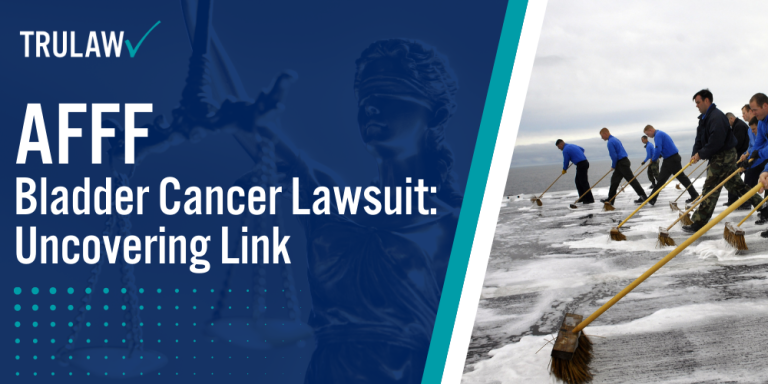
Intro to AFFF Bladder Cancer Lawsuit
Scientific studies have recently associated AFFF firefighting foam with several health issues, such as:
- Widespread Use and Legal Actions: Due to its effectiveness, AFFF has been a staple in military, industrial, and airport firefighting, leading to numerous lawsuits from affected individuals.
- Health Risks from PFAS Exposure: Long-term exposure to PFAS chemicals in AFFF has been associated with an increased risk of developing bladder cancer, prompting legal actions against manufacturers.
- Current Legal Landscape: With over 3,300 plaintiffs in AFFF lawsuits, the legal challenges against AFFF manufacturers are significant and ongoing.
If you or a loved one has been diagnosed with bladder cancer and have a history of AFFF exposure, you may be eligible to pursue compensation.
Contact TruLaw using the chat on this page to receive an instant case evaluation to file for an AFFF Bladder Cancer Lawsuit.
Table of Contents
Why Are Firefighters at Increased Risk of Bladder Cancer Due to AFFF Firefighting Foam?
Firefighters who use aqueous film-forming foam (AFFF) are at an increased risk of bladder cancer, primarily due to the presence of toxic PFAS chemicals in the foam.
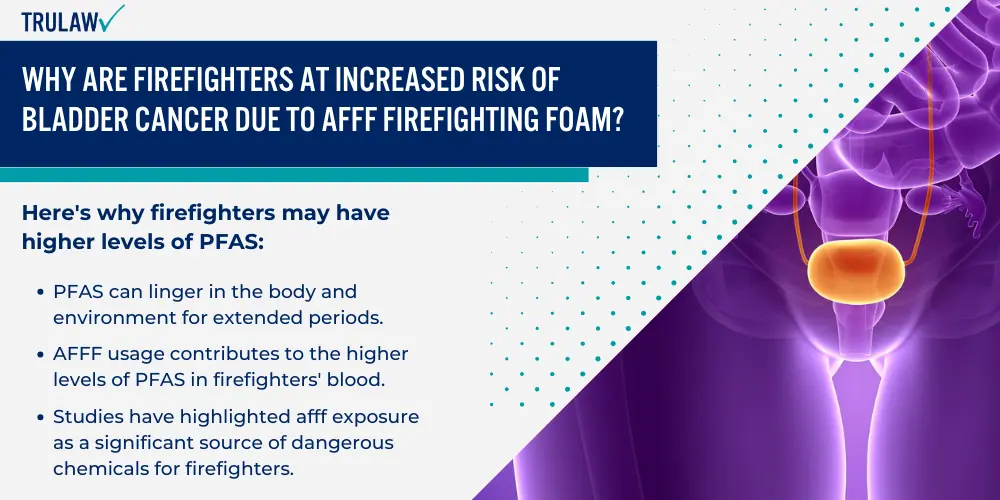
These substances can accumulate in the human body, leading to various health risks.
PFAS in Firefighters’ Blood
Toxic PFAS chemicals, found in AFFF, are known to accumulate in the bloodstream of firefighters.
Here’s why firefighters may have higher levels of PFAS:
- PFAS can linger in the body and environment for extended periods.
- AFFF usage contributes to the higher levels of PFAS in firefighters’ blood.
- Studies have highlighted afff exposure as a significant source of dangerous chemicals for firefighters.
- These substances are associated with several health risks, including cancer.
Research suggests that firefighters have PFAS in their blood at concentrations higher than those in the general population, which is attributed to their occupational exposure.
Health Risks of PFAS Exposure
The exposure to PFAS from AFFF carries several health risks, including an increased risk of bladder cancer.
These are some of the concerning health effects linked to PFAS exposure:
- PFAS are considered toxic chemicals linked to cancer development.
- Studies have reported a higher incidence of bladder and other cancers in firefighters compared to the general population.
- Chronic exposure exacerbates the risk of developing adverse health outcomes.
- Research is ongoing to uncover the full spectrum of health effects resulting from PFAS exposure.
Several types of cancer, including bladder cancer, have been observed with greater frequency among firefighters, a trend that warrants concern according to a study on firefighters’ health risks.
The Growing Concern over AFFF Firefighting Foam Lawsuits
The litigation landscape is being reshaped as AFFF firefighting foam cases gain prominence due to their associated health risks and environmental impact.
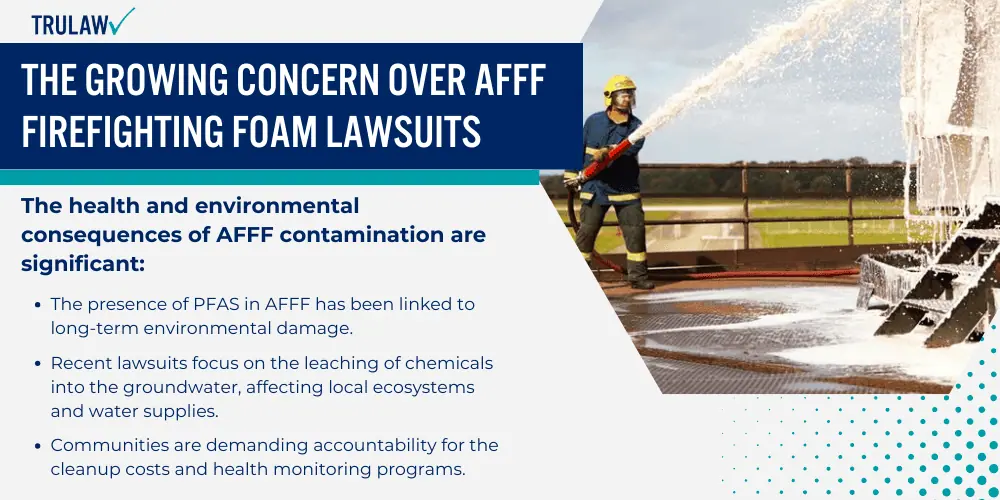
Groundwater Contamination
Aqueous film-forming foam (AFFF) has been widely used for decades by firefighting units for its effectiveness in extinguishing fuel fires.
However, the substances contained within AFFF have been found to contaminate groundwater, leading to a rise in municipal water contamination cases across the United States.
The Environmental Protection Agency (EPA) has acknowledged this concern and is working toward addressing PFAS contamination.
The health and environmental consequences of AFFF contamination are significant:
- The presence of PFAS in AFFF has been linked to long-term environmental damage.
- Recent lawsuits focus on the leaching of chemicals into the groundwater, affecting local ecosystems and water supplies.
- Communities are demanding accountability for the cleanup costs and health monitoring programs.
- Key legal battles have set precedents, where settlements require manufacturers to cover damages related to AFFF contamination.
Cancer-causing Chemicals Found in Human Urine
Investigations into AFFF have revealed more direct concerns for human health.
Research has detected PFAS—the chemicals in AFFF—in human urine, indicating widespread exposure.
These chemicals have been associated with an increased risk of several cancers, including bladder cancer.
Studies show a link between PFAS exposure and increased cancer risks:
- Medical studies present a correlation between PFAS exposure and elevated cancer risks.
- Victims are filing lawsuits after PFAS linked to AFFF usage have been found in their bodies.
- The health effects of PFAS exposure can take years to manifest, complicating legal proceedings.
- Litigants aim to receive compensation for medical expenses, suffering, and other damages resulting from PFAS exposure.
The discourse around AFFF and its potential health risks continues to develop as more cases are brought to light, reflecting a more informed and concerned public.
Determining Your Eligibility for an AFFF Bladder Cancer Lawsuit
When considering an AFFF firefighting foam lawsuit and its potential link to bladder cancer, confirming your eligibility is a foundational step.
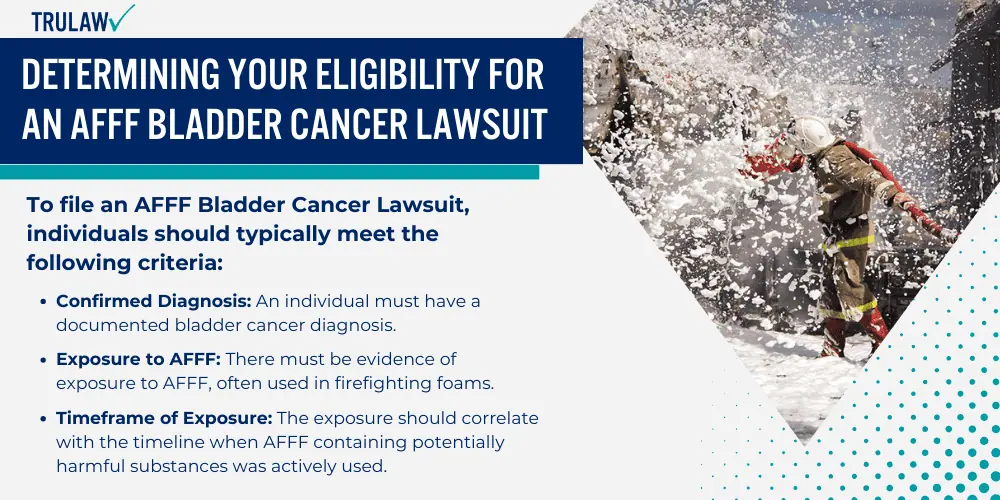
This process involves a careful assessment of personal circumstances against the legal criteria.
Who Can File an AFFF Bladder Cancer Lawsuit?
If you’ve been diagnosed with bladder cancer and suspect it may be linked to exposure to firefighting foam, you may be eligible to file an AFFF Bladder Cancer Lawsuit.
To file an AFFF Bladder Cancer Lawsuit, individuals should typically meet the following criteria:
- Confirmed Diagnosis: An individual must have a documented bladder cancer diagnosis.
- Exposure to AFFF: There must be evidence of exposure to AFFF, often used in firefighting foams.
- Timeframe of Exposure: The exposure should correlate with the timeline when AFFF containing potentially harmful substances was actively used.
- Causal Link: A medical expert will likely need to confirm that the exposure could plausibly be linked to the bladder cancer diagnosis.
Factors Affecting Compensation In AFFF Litigation
Several factors influence the potential compensation, such as:
- Extent of Exposure: Details of how frequently and for how long you were exposed to AFFF are crucial.
- Severity of Illness: The stage and progression of bladder cancer play a significant role in settlements.
- Impact on Quality of Life: Calculations will take into account how the illness has affected daily activities and well-being.
- Economic Damages: This includes medical expenses, lost wages, and other financial losses connected to the diagnosis.
Individuals are encouraged to seek legal guidance to help assess their situation and understand the steps to file an AFFF lawsuit.
Settlement Amounts in AFFF Bladder Cancer Lawsuits
When examining the outcomes of AFFF bladder cancer lawsuits, the financial compensation awarded to plaintiffs can vary based on numerous factors.
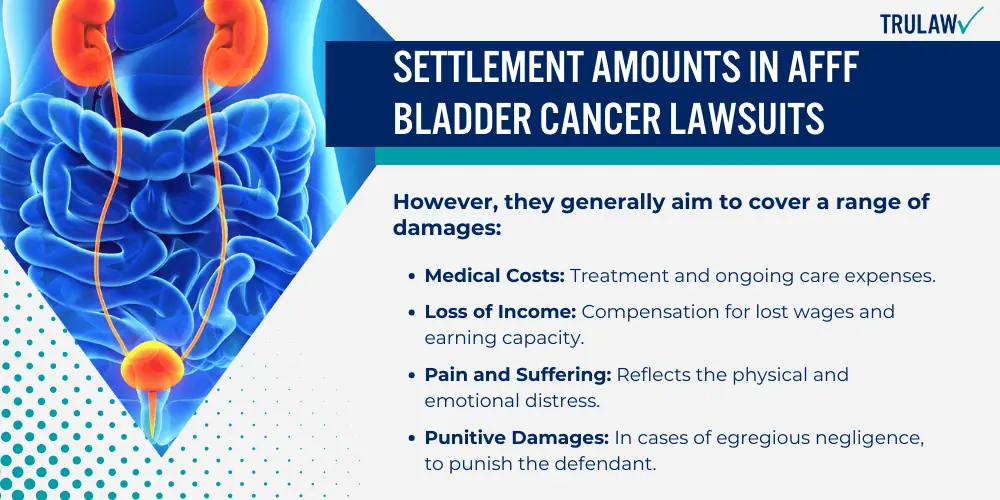
Settlement amounts may reflect the severity of harm, the duration of exposure, and other case-specific details.
Average Settlement Amounts
The average settlement amounts for AFFF bladder cancer lawsuits are not publicly disclosed as they can be confidential.
However, they generally aim to cover a range of damages:
- Medical Costs: Treatment and ongoing care expenses.
- Loss of Income: Compensation for lost wages and earning capacity.
- Pain and Suffering: Reflects the physical and emotional distress.
- Punitive Damages: In cases of egregious negligence, to punish the defendant.
Specific Case Settlements
Looking at specific case settlements, the details are often sealed or undisclosed to the public.
Nevertheless, some notable settlements have been reported:
- In high-profile cases, awards can reach several million dollars if the court finds the defendant’s actions particularly harmful.
- Out-of-court settlements enable faster resolution but might result in a lower compensation amount compared to a trial verdict.
- AFFF firefighting foam MDL class action lawsuit settlements often create a compensation fund where plaintiffs can receive varying amounts based on their individual cases.
- Some settlements include provisions for future medical monitoring of affected individuals.
Each firefighting foam lawsuit involves careful consideration of the unique circumstances, exposure levels, and resulting health impacts.
It’s important to consider that AFFF firefighting foam settlement amounts are influenced by substantial evidence linking the chemical exposure to the plaintiff’s condition.
The Link Between Firefighting Foam and Cancer
Exposure to certain chemicals in AFFF firefighting foams has been linked to increased risks of developing various types of cancer.
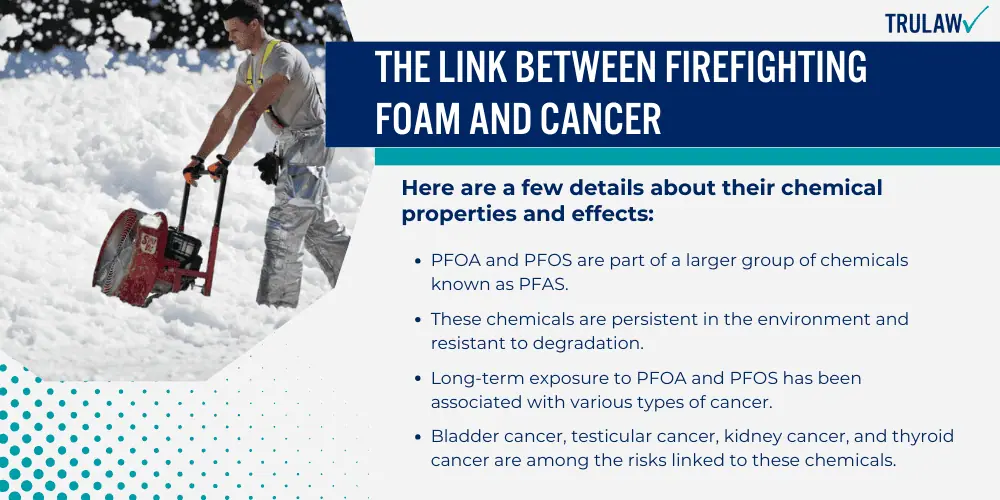
This section emphasizes the hazardous compounds in these foams and the professions most at risk.
PFOA and PFOS: The Culprits
Perfluorooctanoic acid (PFOA) and perfluorooctane sulfonate (PFOS) are primary components that have raised health concerns.
These substances are prevalent in aqueous film-forming foam (AFFF), widely used by firefighters for its effectiveness in combating fuel fires.
However, they have become central to concerns over potential carcinogenic effects.
Here are a few details about their chemical properties and effects:
- PFOA and PFOS are part of a larger group of chemicals known as PFAS.
- These chemicals are persistent in the environment and resistant to degradation.
- Long-term exposure to PFOA and PFOS has been associated with various types of cancer.
- Bladder cancer, testicular cancer, kidney cancer, and thyroid cancer are among the risks linked to these chemicals.
High-Risk Occupations
Certain professions, particularly firefighting, involve regular contact with AFFF, increasing occupational exposure to harmful chemicals like PFOA and PFOS.
Occupations subjected to an increased risk of AFFF exposure include, but are not limited to:
- Firefighters are frequently in direct contact with AFFF during fire suppression activities.
- Firefighting foam cancer lawsuits highlight the occupational risks taken by these professionals.
- The heightened incidence of cancer in occupations involving long-term AFFF use has prompted a surge in AFFF firefighting foam class action lawsuits.
- Developing cancer due to occupational exposure has become a critical concern, leading to action in the legal arena.
How to File an AFFF Bladder Cancer Lawsuit
When considering a lawsuit for bladder cancer related to AFFF, it’s important to understand the role of a qualified attorney and the specifics to look for when choosing legal representation.
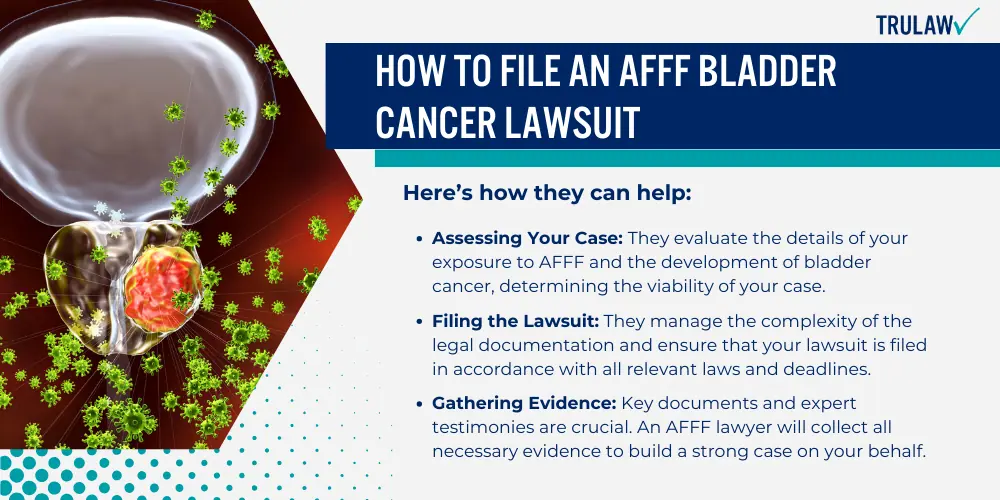
How Can an AFFF Lawyer Help You?
An experienced AFFF lawyer can provide essential assistance throughout the legal process.
Here’s how they can help:
- Assessing Your Case: They evaluate the details of your exposure to AFFF and the development of bladder cancer, determining the viability of your case.
- Filing the Lawsuit: They manage the complexity of the legal documentation and ensure that your lawsuit is filed in accordance with all relevant laws and deadlines.
- Gathering Evidence: Key documents and expert testimonies are crucial. An AFFF lawyer will collect all necessary evidence to build a strong case on your behalf.
- Representing You in Court: If your case goes to trial, your attorney will advocate for you, presenting your case clearly and effectively.
What to Look for in Firefighting Foam Cancer Lawyers
Selecting the right firefighting foam attorney is a significant step in seeking justice.
Consider these points:
- Experience: Look for experienced firefighting foam lawyers who have a proven track record in handling AFFF-related cancer lawsuits.
- Expertise: Make sure they have specific knowledge of the chemicals in AFFF and their link to cancer.
- Resources: A well-resourced law firm can thoroughly investigate your case, often making the difference in the outcome.
- Communication: Choose an attorney who communicates clearly and keeps you informed at each step of the process.
When aiming to file an AFFF bladder cancer lawsuit, having the right legal support can increase the likelihood of a favorable outcome.
Always ensure that your firefighting foam attorneys are adept in managing such specialized cases.
TruLaw: #1 AFFF Bladder Cancer Attorney
TruLaw stands out as a leading legal advocate for individuals who have developed bladder cancer potentially linked to AFFF (aqueous film-forming foam) exposure.
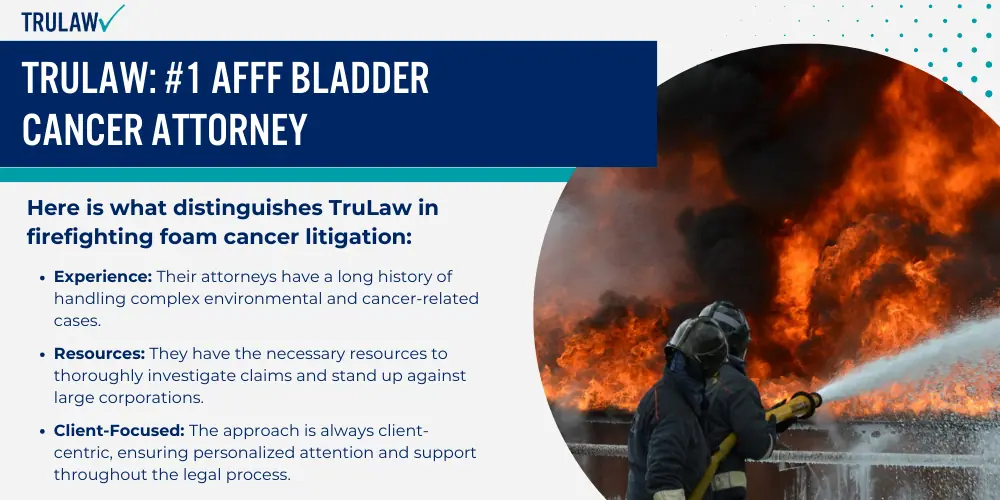
Their reputation as the top AFFF bladder cancer attorneys is built on a foundation of detailed investigation, robust client representation, and updated knowledge of relevant laws and scientific findings.
Their legal team specializes in AFFF-related cancer lawsuits, providing essential guidance to those affected by the risks associated with firefighting foam.
With a focus on obtaining justice and compensation for victims, they leverage their expertise to challenge entities responsible for AFFF production and distribution.
Here is what distinguishes TruLaw in firefighting foam cancer litigation:
- Experience: Their attorneys have a long history of handling complex environmental and cancer-related cases.
- Resources: They have the necessary resources to thoroughly investigate claims and stand up against large corporations.
- Client-Focused: The approach is always client-centric, ensuring personalized attention and support throughout the legal process.
- Results: A track record of securing favorable outcomes for clients impacted by carcinogenic substances, including AFFF.
Victims seeking reparation for their suffering can turn to TruLaw as a source of knowledgeable and steadfast legal representation. TruLaw remains committed to upholding the rights of individuals and striving for the accountability of those responsible.
AFFF Lawsuit Frequently Asked Questions
-
What are the criteria for eligibility in an AFFF cancer lawsuit?
Individuals may be eligible to participate in an AFFF cancer lawsuit if they have been exposed to Aqueous Film Forming Foam and subsequently diagnosed with bladder cancer.
Documented proof of exposure and medical diagnosis is typically required.
-
What is the status of the current AFFF litigation?
The current AFFF litigation is progressing through the court system, with many cases consolidated in multidistrict litigation to streamline the process.
Key decisions and precedent-setting rulings are still unfolding.
-
What factors determine the settlement amount in AFFF bladder cancer cases?
Several factors, including the severity of cancer, the cost of medical treatment, lost wages, and the impact on quality of life, all influences the settlement amount in AFFF bladder cancer cases.
Each case is assessed on an individual basis to determine fair compensation.
-
Can veterans claim VA disability benefits for AFFF exposure?
Yes, veterans who were exposed to AFFF during their service and have developed bladder cancer can file for VA disability benefits.
The condition must be service-connected to qualify for compensation.
-
What legal options are available for those exposed to AFFF and diagnosed with cancer?
Those who have been exposed to AFFF and diagnosed with cancer potentially have legal options including individual lawsuits, joining multidistrict litigation, and in some cases, applying for workers’ compensation or veteran benefits based on service-related exposure.
-
How to choose a competent attorney for an AFFF bladder cancer claim?
To choose a competent attorney for an AFFF bladder cancer claim, research attorneys with experience in environmental exposure cases, check their track record of success with similar cases, and ensure they communicate clearly and effectively throughout the legal process.

Managing Attorney & Owner
With over 25 years of legal experience, Jessica Paluch-Hoerman is an Illinois lawyer, a CPA, and a mother of three. She spent the first decade of her career working as an international tax attorney at Deloitte.
In 2009, Jessie co-founded her own law firm with her husband – which has scaled to over 30 employees since its conception.
In 2016, Jessie founded TruLaw, which allows her to collaborate with attorneys and legal experts across the United States on a daily basis. This hypervaluable network of experts is what enables her to share the most reliable, accurate, and up-to-date legal information with our readers!
Additional AFFF Lawsuit resources on our website:
Here, at TruLaw, we’re committed to helping victims get the justice they deserve.
Alongside our partner law firms, we have successfully collected over $3 Billion in verdicts and settlements on behalf of injured individuals.
Would you like our help?
At TruLaw, we fiercely combat corporations that endanger individuals’ well-being. If you’ve suffered injuries and believe these well-funded entities should be held accountable, we’re here for you.
With TruLaw, you gain access to successful and seasoned lawyers who maximize your chances of success. Our lawyers invest in you—they do not receive a dime until your lawsuit reaches a successful resolution!
AFFF Lawsuit claims are being filed against manufacturers of aqueous film-forming foam (AFFF), commonly used in firefighting.
Claims allege that companies such as 3M, DuPont, and Tyco Fire Products failed to adequately warn users about the potential dangers of AFFF exposure — including increased risks of various cancers and diseases.
Depo Provera Lawsuit claims are being filed by individuals who allege they developed meningioma (a type of brain tumor) after receiving Depo-Provera birth control injections.
A 2024 study found that women using Depo-Provera for at least 1 year are five times more likely to develop meningioma brain tumors compared to those not using the drug.
Suboxone Tooth Decay Lawsuit claims are being filed against Indivior, the manufacturer of Suboxone, a medication used to treat opioid addiction.
Claims allege that Indivior failed to adequately warn users about the potential dangers of severe tooth decay and dental injuries associated with Suboxone’s sublingual film version.
Social Media Harm Lawsuits are being filed against social media companies for allegedly causing mental health issues in children and teens.
Claims allege that companies like Meta, Google, ByteDance, and Snap designed addictive platforms that led to anxiety, depression, and other mental health issues without adequately warning users or parents.
Transvaginal Mesh Lawsuits are being filed against manufacturers of transvaginal mesh products used to treat pelvic organ prolapse (POP) and stress urinary incontinence (SUI).
Claims allege that companies like Ethicon, C.R. Bard, and Boston Scientific failed to adequately warn about potential dangers — including erosion, pain, and infection.
Bair Hugger Warming Blanket Lawsuits involve claims against 3M — alleging their surgical warming blankets caused severe infections and complications (particularly in hip and knee replacement surgeries).
Plaintiffs claim 3M failed to warn about potential risks — despite knowing about increased risk of deep joint infections since 2011.
Baby Formula NEC Lawsuit claims are being filed against manufacturers of cow’s milk-based baby formula products.
Claims allege that companies like Abbott Laboratories (Similac) and Mead Johnson & Company (Enfamil) failed to warn about the increased risk of necrotizing enterocolitis (NEC) in premature infants.
Here, at TruLaw, we’re committed to helping victims get the justice they deserve.
Alongside our partner law firms, we have successfully collected over $3 Billion in verdicts and settlements on behalf of injured individuals.
Would you like our help?
